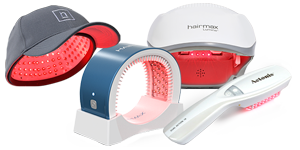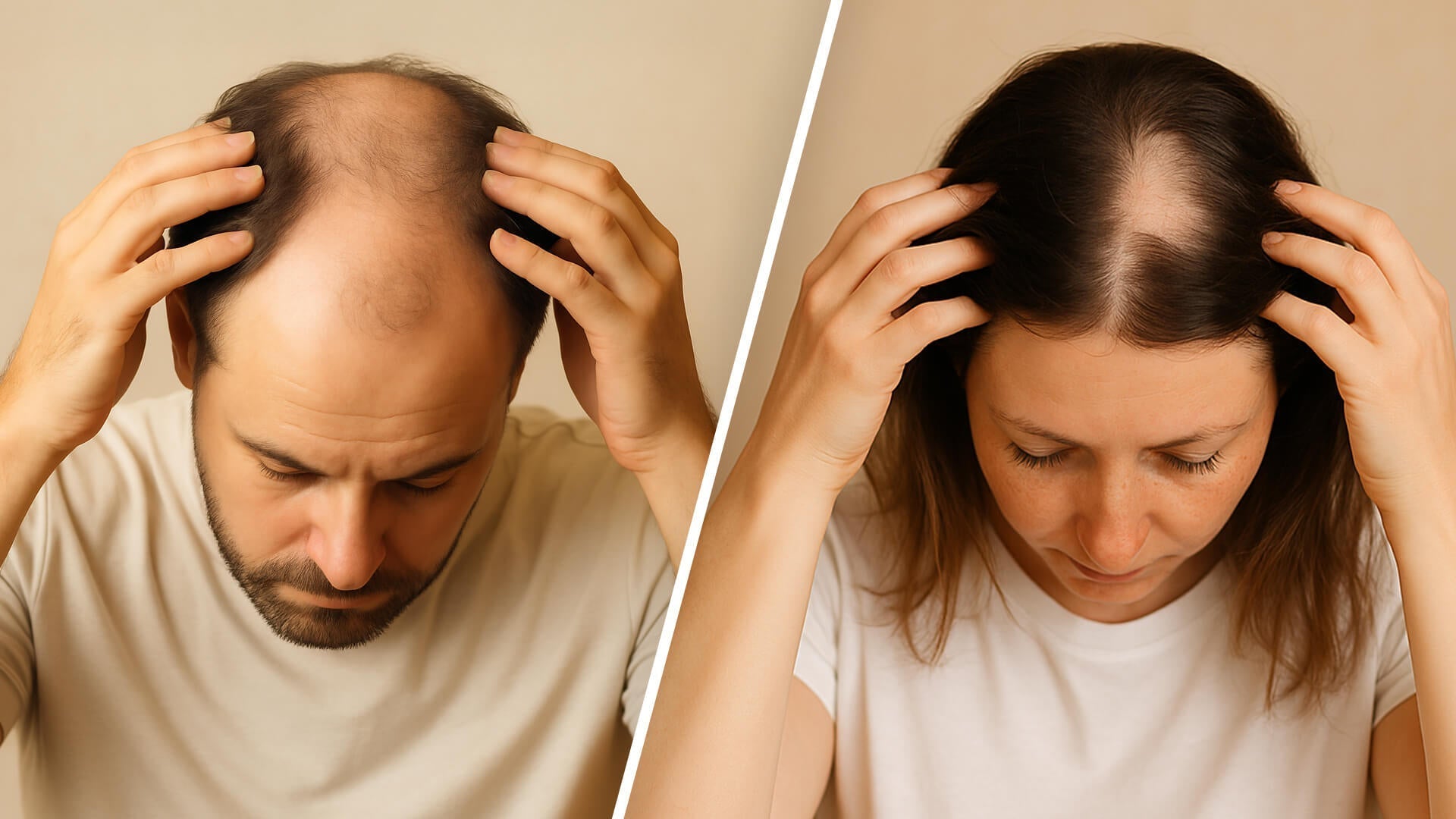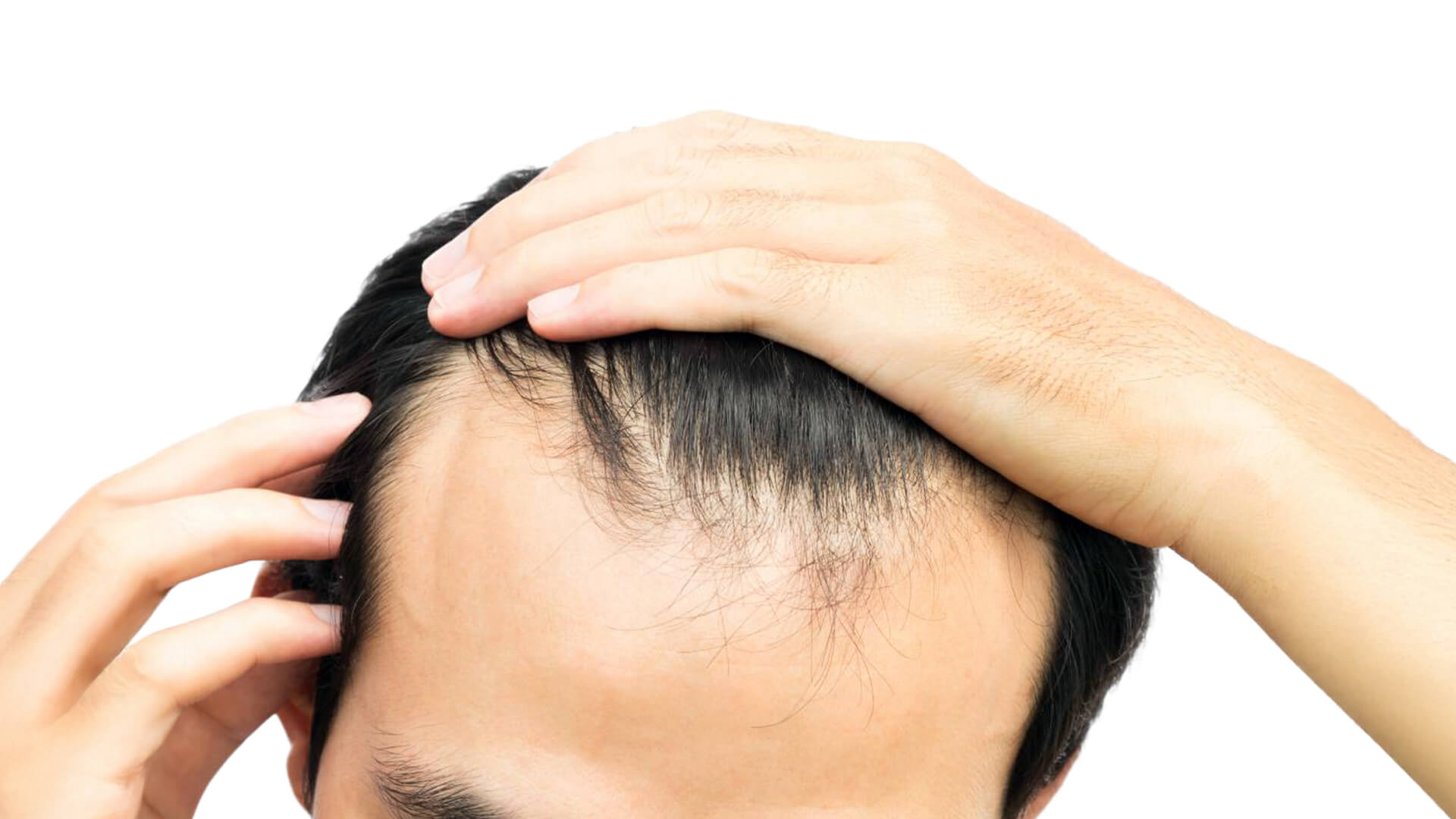Androgenetic Alopecia vs. Alopecia Areata: Understanding the Differences in Symptoms, Causes, and Treatment Options
Hair loss can be confusing and stressful. With so many different causes, it’s easy to feel overwhelmed. In this guide, we’ll break down two common types of alopecia: Androgenetic Alopecia and Alopecia Areata. Understanding the types of Alopecia is the first step in finding the proper treatment and getting your hair back on track.
We’ll walk you through the symptoms, causes, and treatment options for each one. You’ll also learn how to tell them apart and what steps you can take to manage your hair loss. Whether you’re dealing with male pattern baldness, female pattern hair loss, or patchy hair loss, this guide will help you understand it all.
What Are the Main Types of Alopecia?
There are several different types of Alopecia, but two stand out as the most common.
Androgenetic alopecia is the most common type. You might know it as male pattern baldness or female pattern hair loss. It usually happens slowly over time and often runs in families. For many people, it starts with thinning at the crown or a receding hairline. [1]
Alopecia Areata causes sudden hair loss in small, round patches. These patches can appear on your scalp, eyebrows, beard, or even other parts of your body. It can happen at any age and often appears without warning.
Here is a table to help you compare the two:
|
Feature |
Androgenetic Alopecia |
Alopecia Areata |
|
Common Name |
Male/Female Pattern Hair Loss |
Patchy Hair Loss |
|
Cause |
Hormones and genetics |
Immune system attacks hair follicles |
|
Pattern of Hair Loss |
Gradual thinning |
Sudden patches |
|
Affected Areas |
Scalp (top and crown) |
Scalp, beard, eyebrows, body |
|
Reversibility |
Rarely without treatment |
Often grows back |
|
Treatments |
Medications, laser therapy |
Steroids, immunotherapy, supplements |
Understanding Androgenetic Alopecia
What Is Androgenetic Alopecia? [2]

Androgenetic Alopecia is one of the most common types of Alopecia and often runs in families. It’s a genetic condition where certain hormones, especially androgens, affect the hair follicles over time. These hormones can shrink the follicles, causing the hair to grow back thinner and shorter with each cycle. Eventually, the hair may stop growing altogether.
This kind of hair loss shows up differently in men and women. In men, it usually starts with a receding hairline or a bald spot at the crown. Over time, the two areas may meet, creating a larger bald patch. In women, the hair tends to thin across the top of the scalp, especially along the part, but they rarely go completely bald.
What Are the Symptoms?
The signs of Androgenetic Alopecia develop slowly. You might notice your hair becoming thinner over the years, especially at the top. Men’s hairlines may start to move back, while women often notice their part becoming wider. Unlike other scalp conditions, there’s usually no redness, itching, or discomfort. Just steady hair loss that can be difficult to notice at first.
What Causes It?
The main cause of Androgenetic Alopecia is your genetics. If your parents or grandparents had this hair loss, you’re more likely to have it too. Hormones also play a big role, especially as you get older. Natural changes happening in the body with age, especially changes in androgen levels, can trigger hair thinning more quickly as well.
How Can You Tell If You Have It?
If your hair loss has come on slowly and seems to follow a pattern, like a receding hairline or thinning at the crown, it may be Androgenetic Alopecia. It doesn’t cause pain or scalp irritation and often runs in families. If you’re unsure, a doctor or dermatologist can take a closer look and help you figure out what’s going on.
How Is It Treated?
There are a few ways to treat Androgenetic Alopecia, depending on what you’re comfortable with and how early you start.
-
Laser therapy devices, such as laser caps or combs can be extremely beneficial. These tools use light to help improve blood flow to the scalp, which can wake up weak hair follicles and support new growth.
-
Hair shampoos and conditioners for thinning hair are excellent especially, when used in conjunction with laser therapy devices. With regular use, they may help strengthen the hair you have and maintain a healthier scalp.
-
Serums and supplements are another great option for hair regrowth. Some contain ingredients like biotin, zinc, or saw palmetto, which support hair health from the inside out.
-
Medications like finasteride (for men) and minoxidil (for both men and women) are often used too. They can be effective, but they may cause negative side effects in some people. Therefore, it’s important to talk to a doctor before starting them.
Are There Natural Options?
Laser therapy is a non-invase, drug-free option that significantly helps to stimulate hair regrowth in some cases.
Additionally, some supplements for hair and scalp health like Actonis Dual Action Supplements are in fact natural and highly effective.
Scalp massages are a simple method that helps increase blood flow and can be relaxing. Some people even pair their massages with essential oils, like rosemary or peppermint oil, which may support healthy hair growth when used regularly with a carrier oil.
A healthy diet can also make a big difference. Eating enough protein, iron, and vitamins like B12 and D can support strong, healthy hair.
What Is Alopecia Areata? [3]

Alopecia Areata is one of the more unpredictable types of Alopecia, and it can show up without warning. It happens when your body’s immune system mistakenly attacks your hair follicles. Normally, your immune system protects you from illness, but in this case, it targets the hair roots and causes the hair to fall out.
The condition can affect anyone, regardless of age or gender, and the hair loss can come on suddenly. For some people, it might just be a small patch of missing hair on the scalp. For others, it may spread to other body parts, like the eyebrows, eyelashes, or beard. In rare cases, it can lead to complete hair loss on the head or body.
What Are the Symptoms?
The most common sign of Alopecia Areata is one or more small, round bald patches. These patches often appear out of nowhere and may grow larger over time. You might notice a tingling feeling or itch in the area just before the hair falls out. The skin where the hair is missing usually looks smooth and healthy, with no rash or flaking.
Some people also notice changes in their fingernails or toenails. Tiny dents, ridges, or rough spots can appear, which may indicate the immune system’s involvement.
What Causes It?
The exact cause of Alopecia Areata isn’t fully understood. However, experts agree it’s linked to a problem with the immune system. In people with this condition, the immune system gets confused and attacks healthy hair follicles. This is why it’s considered an autoimmune disorder.
Certain factors may increase your risk - Such as, you might be more likely to get it if someone in your family has had Alopecia Areata or another autoimmune condition. Emotional and physical stress can also play a role. In some cases, viral infections or major life events have been linked to the start of symptoms.
How Is It Diagnosed?
If you think you might have Alopecia Areata, visit a doctor or dermatologist. They usually start by looking at your scalp and asking about your hair loss history. They may gently pull on your hair to see how easily it comes out, or examine your nails for signs of change.
In some cases, they might suggest a scalp biopsy, which involves taking a tiny skin sample to examine under a microscope. Blood tests can also help rule out other health problems or confirm if the immune system plays a role.
Can Hair Grow Back?
Yes, in many cases, the hair does grow back. Some people experience just one episode, and their hair returns to normal after a few months. Others may go through cycles of losing and regrowing hair. It can be hard to predict how each case will go. The good news is that even when hair falls out, the follicles usually stay alive, so there’s still a chance for regrowth especially if immediate action is taken.
How Is It Treated?
There’s no one-size-fits-all treatment for Alopecia Areata, but several options can help manage it. The right treatment often depends on how much hair you’ve lost, where it’s missing, and how long it’s been gone. The following are some common treatment approaches:
1. Topical corticosteroids are creams or ointments that help calm your skin’s immune response. They are often used on small patches and may help new hair grow faster.
2. Steroid injections for more stubborn spots. These are given directly into the bald areas to reduce inflammation and jump-start the hair growth process. This treatment is usually done every few weeks.
3. Topical immunotherapy is often used for more widespread hair loss. It works by tricking the immune system into reacting to something else, which helps stop it from attacking the hair follicles.
4. Supplements and vitamins that support healthy hair growth may also be helpful. Nutrients like biotin, vitamin D, and iron can support your hair from the inside, especially if you’re low in any of them.
Key Differences: Androgenetic Alopecia vs. Alopecia Areata
Let’s take another quick look at the difference between Androgenetic Alopecia and alopecia areata:
|
Factors |
Androgenetic Alopecia |
Alopecia Areata |
|
Onset |
Gradual |
Sudden |
|
Cause |
Genetic and hormonal |
Autoimmune |
|
Pattern |
Diffuse or patterned thinning |
Patches |
|
Regrowth |
Hard without treatment |
Often regrows with or without help |
|
Affects |
Mostly adults |
Children and adults |
Other Types of Alopecia You Should Know[4]
We’ve focused on the two most common kinds so far, but several other types of Alopecia are important to understand. Knowing about these can help you and your doctor figure out the real cause of your hair loss and choose the right treatment.
1. Telogen Effluvium – This hair loss usually happens after stress, illness, or major life changes. It causes hair to shift into the resting phase and fall out all at once. The good news is that it’s usually temporary, and the hair often grows back.
2. Traction Alopecia – This happens when hair is pulled too tightly for long periods, often from hairstyles like tight ponytails, braids, or extensions. Over time, the constant tension can damage the hair follicles. If caught early, the hair can regrow, but long-term pulling may cause permanent loss.
3. Cicatricial Alopecia (Scarring Alopecia) – This is a more serious type where the hair follicles are damaged and replaced with scar tissue. It can cause permanent hair loss and comes with symptoms like redness, swelling, or itching. Treatment focuses on stopping the inflammation to prevent further damage.
4. Anagen Effluvium – This type of alopecia causes hair to fall out suddenly during the growth phase. It’s most commonly seen in people undergoing chemotherapy or exposed to toxic substances. Hair often starts to grow back once the treatment or exposure ends.
Learning about these different types can help you feel more prepared when talking with your doctor or dermatologist. It’s the first step toward getting answers and finding the best treatment for your hair and scalp.
When to See a Specialist
The sooner the better! See a doctor if you’re unsure whether your hair loss is due to Androgenetic Alopecia, Alopecia Areata, or another condition. This is especially important if your hair loss is sudden, patchy, or more severe than usual. Getting an early diagnosis means you can start treatment sooner, which increases your chances of keeping your hair and preventing further loss. A doctor can help you understand what’s happening with your scalp and recommend the correct treatment.
How Our Products Can Help
Hairmax focuses on non-invasive, drug-free solutions that support healthy hair regrowth. We offer a range of products and can help you find the right solution for your unique needs, lifestyle, and budget.
1. Laser Cap – These are safe, hands-free devices that you wear like a regular cap. They use low-level laser therapy to improve blood flow to your scalp and provide optimal energy for maximum follicle stimulation.
2. Laser Combs – Perfect for treating smaller or targeted areas, these handheld devices use gentle laser light to encourage hair growth where you need it most.
3. Hair Serums and Conditioners – These products nourish thinning hair and support scalp health. With regular use, they can strengthen strands and reduce breakage.
4. Hair Growth Supplements – Packed with vitamins and nutrients like biotin, iron, and zinc, these supplements support healthy hair growth from the inside out.
Conclusion
Hair loss can feel overwhelming, but you’re not alone, and it’s not the end of the road. Whether you’re facing Androgenetic Alopecia, Alopecia Areata, or another type of Alopecia, treatments and tools are available to help you take control.
The first step is understanding what kind of hair loss you’re dealing with - Once you know, you can work with your doctor to create a plan. Acting early gives you the best chance to protect your hair and even regrow some of what’s been lost.
From laser therapy devices to nourishing shampoos, serums, and supplements, we have options for your unique needs and lifestyles. Explore what’s available and choose what feels right for you.
Sources
[1] https://www.ncbi.nlm.nih.gov/sites/books/NBK538178/
[2] https://pmc.ncbi.nlm.nih.gov/articles/PMC4954340/
[3] https://thekingsleyclinic.com/resources/alopecia-areata-comprehensive-guide-to-symptoms-and-treatments
[4] https://www.dermatologyadvisor.com/features/types-of-alopecia










